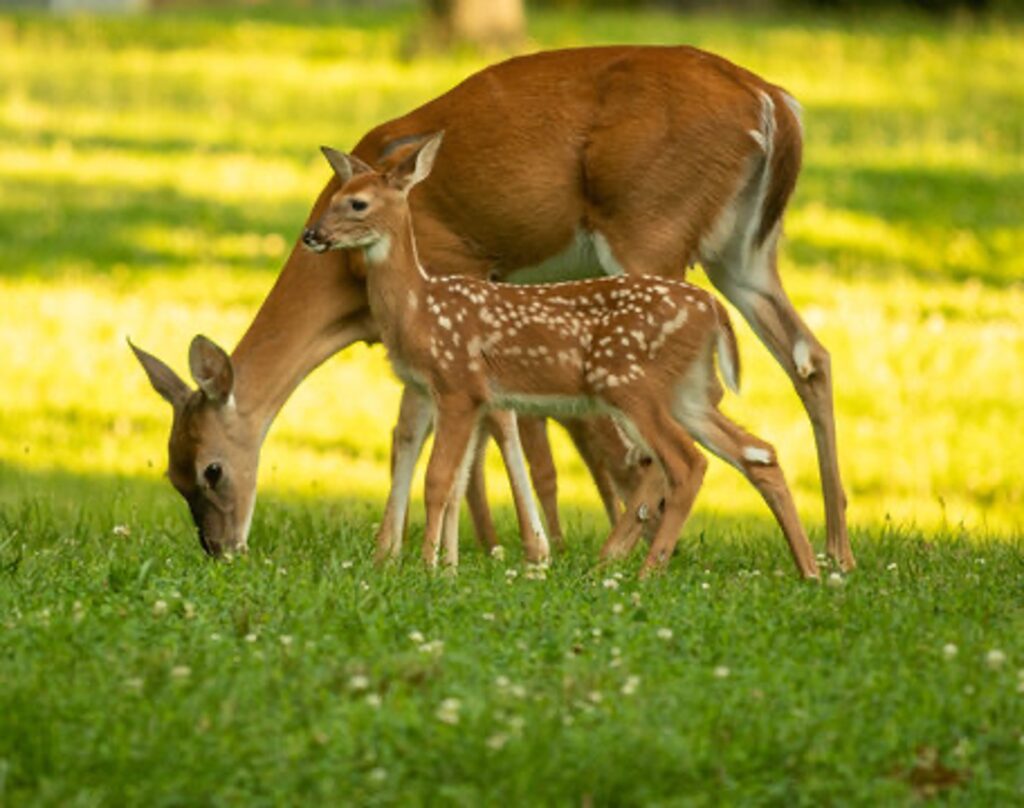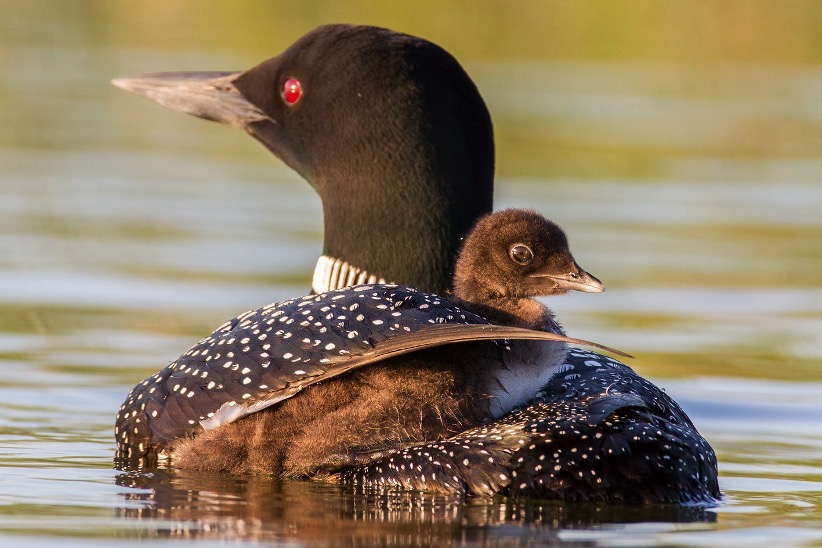Deer, rabbits, squirrels, chipmunks, a fox or two and even coyotes populate our dry landscapes. Muskrats, beavers, a variety of turtles, frogs, and toads greet us at the waters edge. Some are welcome and some eat up our flowers, but most are fun to watch.
Nuisance Wildlife: Beavers have posed a larger threat than other animals as they chew down our trees and/or weaken their stand creating a safety issue.
CLHA has taken action over the last several years to reduce the beaver population by working with licensed professionals who are permitted through the DNR. Most of the nuisance beavers migrate to the lake from Lake Minnetonka.


A popular App to put on your phone is Merlin Bird ID. It identifies birds based on sounds you record. Highly recommended by our local birder Karen Vance.
The Common Loon: Christmas Lake is fortunate to have a pair that return each year. They nest on a raft the Christmas Lake Road neighbors launch each spring. The pair usually hatches one to two Loonlets each season. Watch for email updates with loon arrival and loonlet births. Please keep your distance as you see the loon family navigate the lake during our summer season.
Trumpeter Swans: since 2004 swans have been using Christmas Lake as a stop-over on their flyway during their winter migration south. At first a small number of swans stayed for a few days, and by 2011 that number had grown to over four dozen in three different groups who stayed on the lake for more than a month. Christmas Lake is deeper than surrounding lakes, and usually the last in the neighborhood to freeze over, the swans can swim and feed later in the season.
Songbirds: including permanent residents like chickadees and cardinals, as well as seasonal migrants. Some common songbirds to look for include American Goldfinches, Northern Cardinals, Yellow Warblers, Baltimore Orioles, House Finches, Blue Jays, Cedar Waxwings, Dark-eyed Juncos, Black-capped Chickadees, and Chipping Sparrows. You might also see Mourning Doves, Downy Woodpeckers, Red-breasted Nuthatches, and White-breasted Nuthatches.
Hummingbirds: Ruby Throated Hummingbirds
Eagles and Hawks: Bald Eagles, Red Tailed Hawks and the occasional Peregrine falcon are seen swooping over and around the lake, fishing for their meals.
Herons: Blue Herons and Green Herons are seen on the Lake
Ducks: Mallards, Wood Duck, Ring Neck and Blue Wing Teal can all be seen on the lake
Woodpeckers: Pileated and Downy woodpeckers are most commonly seen along our shore
Owls: Barn, Barred, Great Horned are most commonly seen. A nest along Ridge Road is an annual home to owls or hawks each year.
Wild Turkeys: Once extirpated from Minnesota, wild turkey restoration has been a phenomenal success. Today’s turkey population descended from a successful release of turkeys that occurred between 1971 and 1973 when 29 adult wild turkeys were trapped in Missouri and transplanted to Houston County in extreme southeastern Minnesota. Since this modest beginning over 30 years ago, Minnesota’s population has grown to more than 70,000 wild turkeys.
Nuisance Wildlife: While Canada geese are often enjoyable to watch, large populations can quickly become a nuisance, especially around lakes, docks, and beaches. One goose produces 2–4 pounds of feces daily, which poses health risks, particularly for children and swimmers. Their numbers have grown significantly due to abundant habitat, low predation in suburban areas, and high reproductive rates. With ideal conditions, short grasses, open sightlines, and access to water—lakeside lawns and parks offer perfect habitat.
Goose populations grow rapidly: a few breeding pairs can turn into hundreds within a decade. Avoidance methods offer temporary relief but shift the problem elsewhere. The most effective long-term solution is controlled hunting, supported by the DNR and available to local governments upon request. CLHA has actively addressed this issue by partnering with licensed professionals and working within DNR regulations to round up and remove a portion of the local goose population that frequents Christmas Lake. This population control option may not be available in the future.
Christmas Lake is 267 acres, with a maximum depth of 87 feet. It is located southeast of the City of Excelsior, in southwestern Hennepin County. Public access is provided by a City of Shorewood -owned boat ramp located on the northwestern shore. Christmas Lake is a unique metro lake with exceptionally clear water and abundant summer dissolved oxygen. Eurasian watermilfoil and zebra mussels are present in Christmas Lake.
Past management of Christmas Lake focused on establishing a put-and-take trout fishery. Since the discontinuation of trout stocking after May 2016, Christmas Lake management has shifted towards Northern Pike, Largemouth Bass and Bluegill fisheries. A Standard Survey was conducted during the summer of 2023 to assess fish populations.
Northern Pike numbers were high, with 7.2 fish per gill net sampled in 2023. Pike averaged 22.4 inches, with the largest measured at 34.6 inches. The Northern Pike population in Christmas Lake could benefit from the Northern Pike north-central zone regulation that took effect in 2018, where 10 fish may be kept, but not more than 2 over 26″ and all fish from 22-26″ must be immediately released. Sixty-nine percent of pike sampled were outside of the protected slot.
Largemouth Bass sampling was not conducted in 2023. Five bass were incidentally sampled in the gill nets and trap nets, ranging in length from 5.3 to 14.4 inches. When bass electrofishing was previously conducted, in 2018, the fish were abundant, and size ranged between 10.3 and 18.6 inches.
Bluegill abundance in Christmas Lake was high, with 61.7 fish per trap net sampled. Bluegill averaged 5.9 inches, with the largest measured at 8.6 inches. While there are a lot of small individuals in the population, anglers still have an opportunity to catch fish greater than 8 inches.
Other fish species sampled in low abundances were Brown Bullhead, Black Crappie, Bowfin, Green Sunfish, hybrid sunfish, Pumpkinseed, Yellow Perch, and Yellow Bullhead. No Rainbow Trout were sampled.
Copyright 2024 Christmas Lake. All Rights Reserved
Contact: info@christmaslake.org